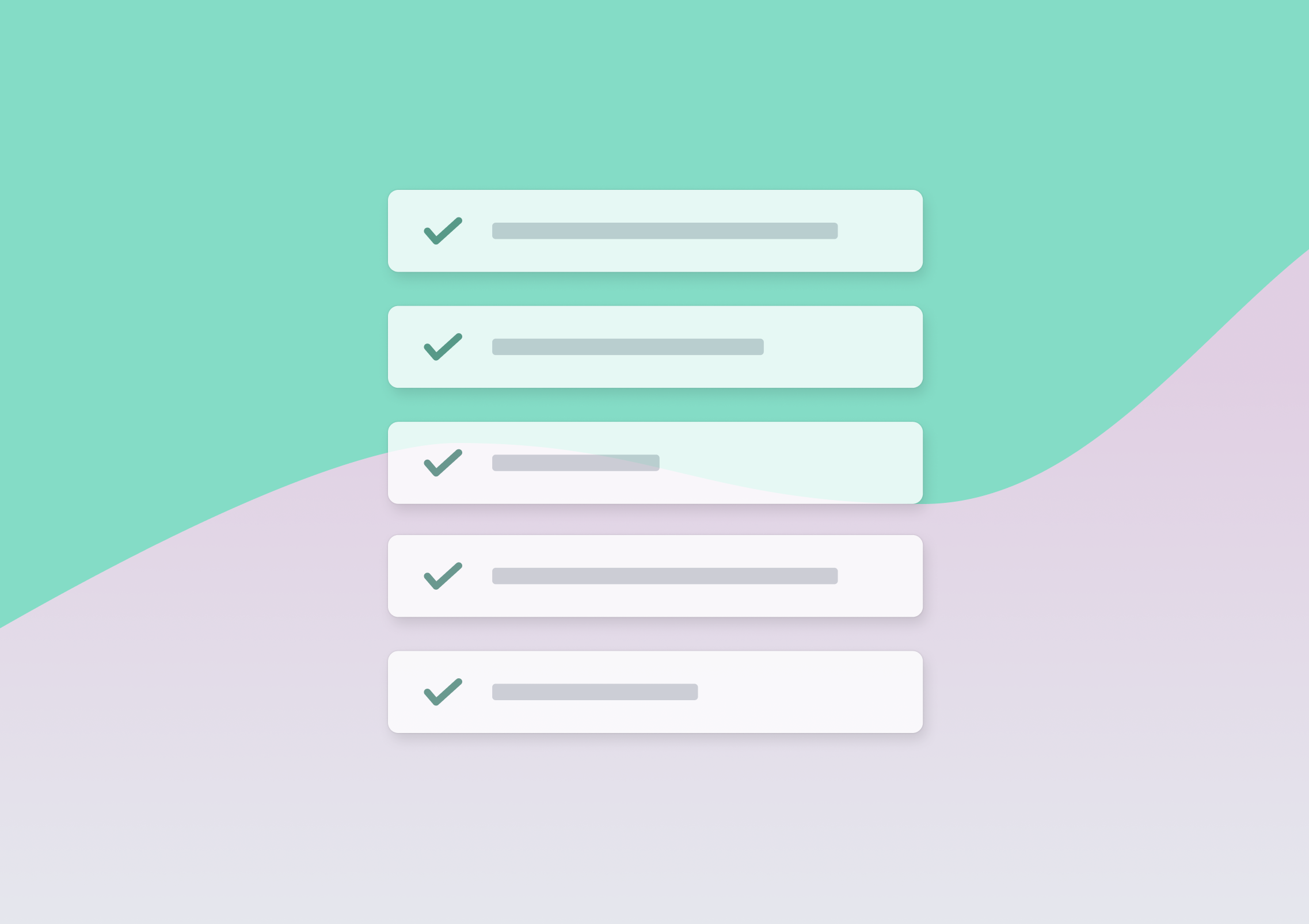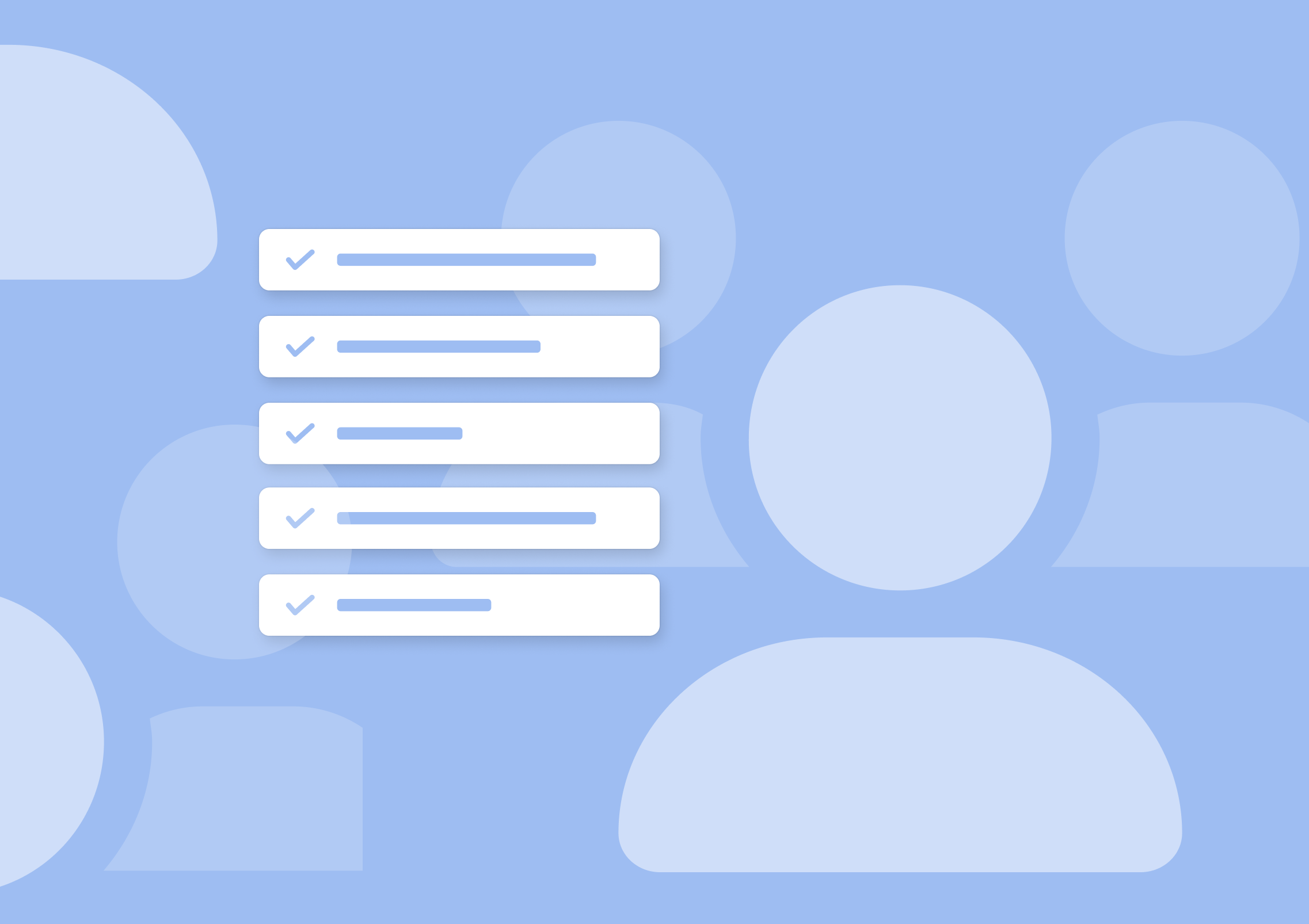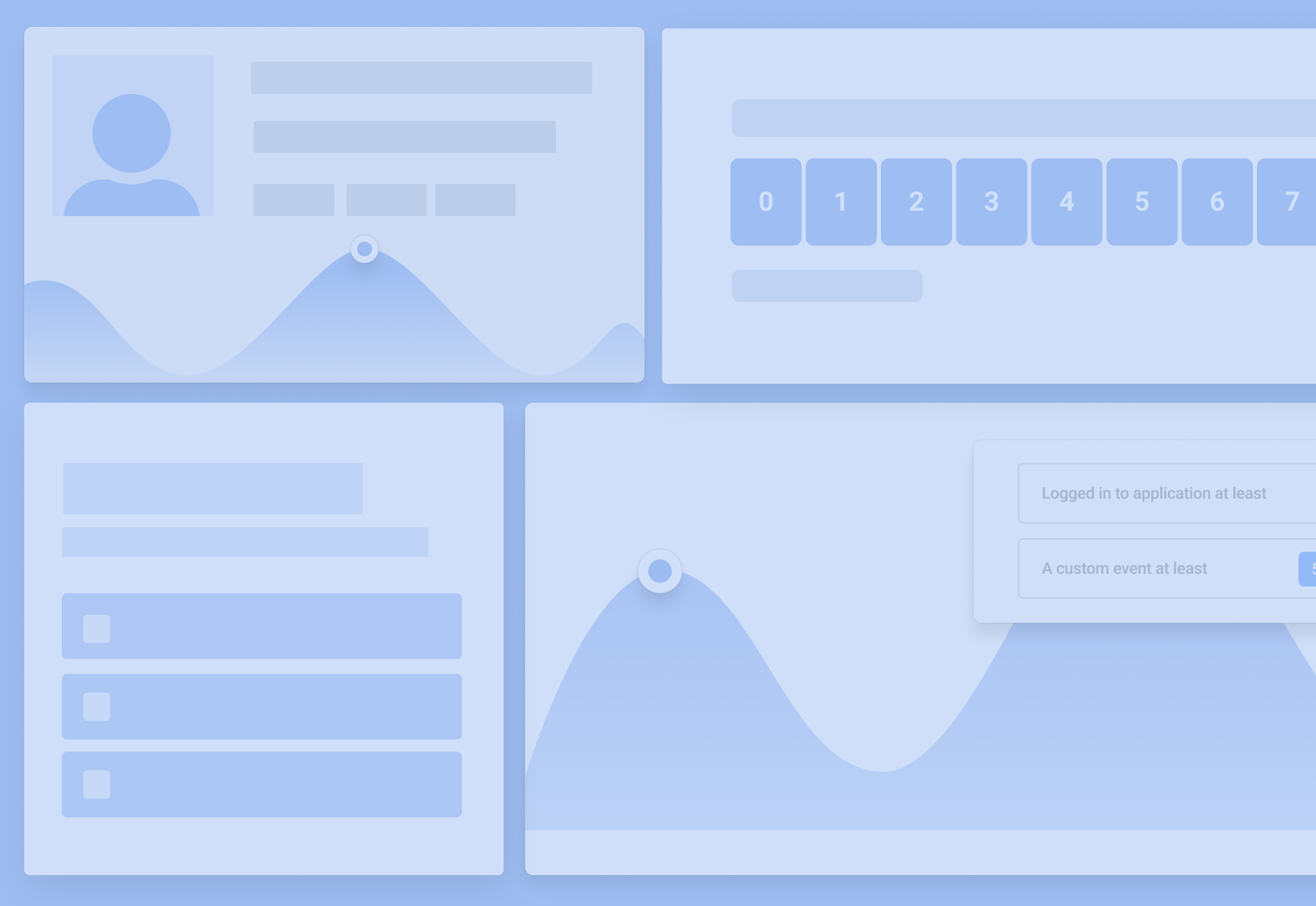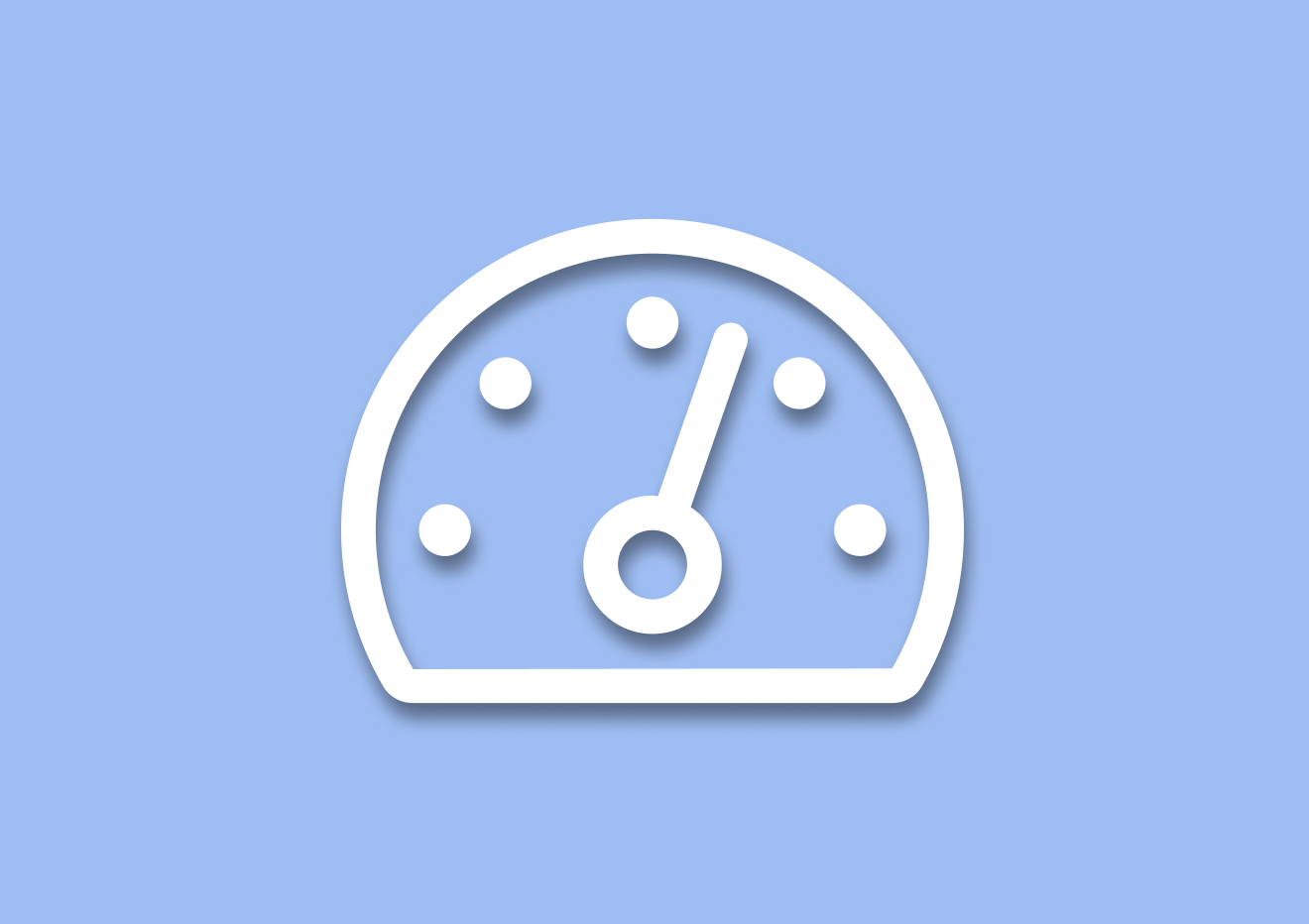This is How You Launch a Voice of the Customer Program in SaaS
Ask any founder about what factors make SaaS successful, and I bet most will recite the list in one breath:
- Great product that solves a real problem.
- Amazing customer experience.
- Incredible customer loyalty.
- A memorable brand, etc.
The thing is – How do you know if you’ve succeeded with any of these factors? And even more importantly, how do you know where you fall short?
Funny thing – The answer lies with your customers, actually.
It doesn’t matter what issues you’re struggling with in your SaaS now – low MRR, high churn, slow growth… Your customers hold the key to unlocking the solution.
This guide will show you how to tap into that solution. Specifically, we’ll discuss how you can transform your SaaS by launching a voice-of-the-customer program.
You’ll learn:
- What a voice of the customer program is.
- Why so many SaaS brands have turned to the voice of the customer programs already.
- How to collect the voice of the customer for your SaaS.
- How to structure the voice of the customer program.
- Examples of typical voice of the customer questions.
- Tools to launch the customer program’s voice, and more.
Intrigued? Let’s take it from the top, then.
What is a Voice of the Customer Program?
Let’s break it into two separate definitions:
The term – Voice of the customer (VOC) – refers to customers’ feedback about their experiences with your products or services and their expectations for those.
Interesting fact: The term isn’t actually any new. Two researchers, Abbie Griffin and John R. Hauser, first used it in a 1993 paper of the same title to describe a process used by the US and Japanese manufacturing companies for, as they write in the paper, “identifying customer needs, structuring customer needs, and providing priorities for customer needs” to use these insights to drive R&D, and product development.
(You can read the full paper here.)
When evaluating VOC, you focus on customers’ needs, expectations, and perceptions of the product to uncover and use this crucial customer data to improve the product and drive the customer experience (CX).
In fact, the VOC data can reveal quite several insights to drive your business forward:
- It can reveal why customers need your product and why they chose you rather than the competition.
- With VOC, you can uncover how else you could help them overcome their problems (or how you could do it better.)
- VOC data will also reveal your customers’ expectations.
- You’ll learn how customers feel about your brand and product.
- And how they behave at different stages of their buying journey.
Voice of the customer program, on the other hand, is the actual campaign you run to uncover, analyze, and implement the VOC feedback in your company.
In practical terms, a voice of the customer program focuses on capturing customer feedback using different methods like customer surveys, focus groups, customer interviews, net promoter score (NPS) surveys, and more.
Here’s an example of an NPS survey used to collect VOC feedback. Later in this guide, I’ll show you all the VOC program methodologies that work particularly well for SaaS.
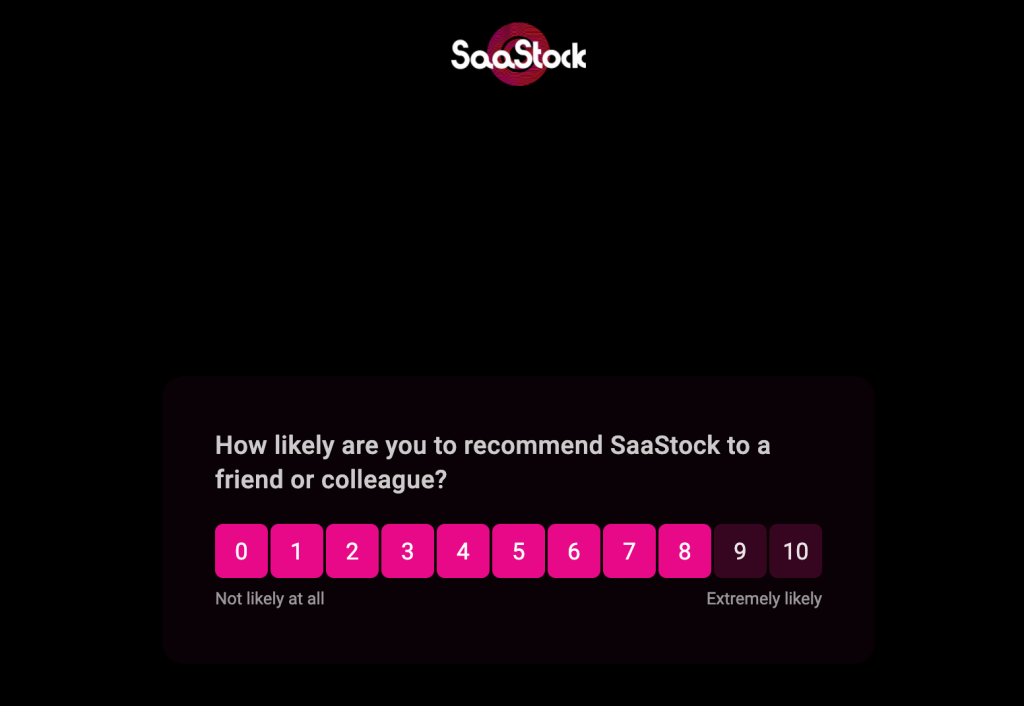
Why do so many SaaS brands turn to the voice of the customer programs?
Well, the shortest and most obvious answer is because it helps them grow and increase the bottom line.
But I agree; such an answer is like saying that eating fruit is good because it’s healthy. It hardly explains anything, let alone tells you the reasons why.
So, let’s take a different approach here and go through some of the biggest benefits of launching a voice of the customer program for a SaaS business.
#1. VOC feedback helps spot problems before they escalate
The data makes a grim outlook here:
- Customer expectations are at an all-time high
- Customer experience is becoming the key brand differentiator
- 1 in 3 customers will leave a brand they love after just one bad experience
- 92% would completely abandon a company after two or three negative interactions
Why grim? Well, because brands are still struggling to catch up.
There’s plenty of data to prove it too. Just do a quick search online, and you’ll see quite worrying stats popping up.
Customer feedback – whether collected directly or indirectly – can help you identify potential problems before they escalate and eliminate them before they put a stain on your brand.
#2. VOC data will help you customize the product to customer needs, wants, and expectations
This pretty much sounds like a cliche now, but it’s so true:
Customer feedback is beyond critical for product development. It’s how you uncover customers’ true expectations and challenges and hear their ideas on how to fix them.
So, by running VOC programs continuously, you get an unparalleled chance to create a product that fits customer expectations like no other.
#3. With VOC, you can uncover ways to increase retention and reduce churn
This is not just me saying this, by the way.
According to a report published by the Aberdeen Group, companies with a strong VOC program enjoy a 55% greater customer retention rate.
Yes, you read it right – 55%
(Actually, the top 20% of companies by performance (best-in-class) achieved retention rates of around 87%.)

(Data from the Aberdeen Group report)
Granted, this data does not relate exclusively to SaaS. But even if we assume a slightly lower performance in our industry (which I don’t think is true anyway,) the results are still massive.
#4. Greater profits
If you think about it…
- Having better products will attract more customers.
- Higher retention rates and lower churn will increase your MRR.
- Better word of mouth will boost growth.
- Finally, lower customer service costs (again, research proves that VOC can drop those by a staggering 23%) will certainly boost your income too.
But all these things will also positively affect your profits.
The Best Methods to Collect Voice of Customer Feedback in SaaS
Voice of the customer is all about listening and acting on what your customers say about your brand, product, experience, etc.
You can use a whole range of methods to collect it – from actively pursuing feedback to monitoring what your customers say about you online.
Below, I’ve listed the most effective methods for collecting the voice of the customer in SaaS.
#1. Customer satisfaction surveys
Customer satisfaction surveys, as the name suggests, are surveys used to figure out whether or not the customers are satisfied with your product or service (and why).
You can use three different methods to collect this feedback:
Net Promoter Score (NPS)
Net Promoter Score surveys measure customer loyalty by evaluating a customer’s likelihood to recommend a product or service to others.
The most common NPS question asks customers to rate how likely they are to recommend a product to a friend or colleague.

Because NPS uses a rating question, based on the replies, you can assess how many of your customers are:
- Promoters – the most loyal customers, who not only can’t imagine living without your product but would also be willing to tell others about it and recommend your business.
- Passives – Happy customers however not satisfied enough to tell everyone they know about you.
- Detractors – Dissatisfied customers who, most likely, would never buy from you again.
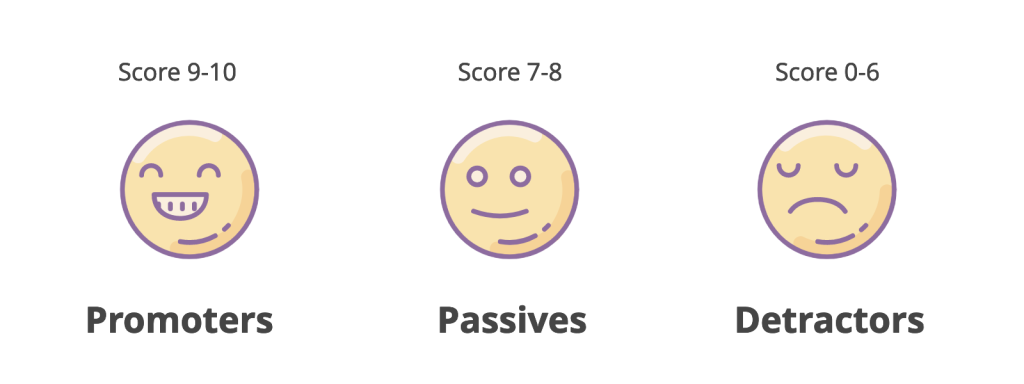
Customer Satisfaction Score (CSAT)
The CSAT survey, on the other hand, aims to uncover how satisfied customers are with your product or service. You can use this type of a survey to measure customer attitude towards your business at crucial touchpoints (i.e. customer service, sales, billing, etc.)
Just like NPS, CSAT is a single-question survey and asks customers to answer by selecting a relevant rating.

Customer Effort Score (CES)
Finally, the customer effort score reveals how easy or difficult it is to use/interact with your product or service and its features
Once again, this customer satisfaction survey type uses a single question to uncover customers’ attitudes.
It looks like this:

#2. Customer interviews
Interviewing customers is, by far, the most effective way to collect VOC. First of all, sitting down with a customer to chat builds a trusting relationship with them. It also makes the feedback very personal.
But unfortunately, it is also the most difficult VOC method to scale and, often, the most costly.
That said, if you could interview the best customers or organize them into a small focus group, you’d gather some of the most insightful ideas and feedback.
#3. Social media
Social media platforms like Facebook, Twitter, Instagram, and others allow you to collect VOC in two ways:
- You can passively listen and monitor what customers say about your brand online.
- And you can tap into those conversations and prod a little deeper to uncover more insights.
Unfortunately, using social media in the voice of the customer program has a downside too. It’s pretty hard to turn your findings into hard data that you can analyze as part of the larger program.
#4. Online reviews
Sites like G2 Crowd, GetApp, Capterra, or Software Advice are a true treasure trove of customer opinions and feedback. What’s more, most of these sites structure reviews in a similar way, making it relatively easy to turn those insights into actionable data.
The qualitative feedback, on the other hand, helps you better understand customers’ needs and can lead to actionable insights.

#5. In-person surveys
This method for collecting the voice of the customer bridges the gap between online surveys and customer interviews. Just like with surveys, you ask customers a series of questions, but you do it in-person, at a meeting, or through a Zoom call.
A major benefit of running certain surveys in person is that you can ask follow-up questions and uncover your customers’ deep motivations for their answers.
#6. In-app surveys
Sometimes the best way to get quality feedback about a product is by asking for it when customers are immersed in it. And there is no better method for that than running in-app surveys.
In-app surveys display directly in your product. Because of this precise targeting, they help you collect highly contextual information from customers.

#7. Feedback forms
Feedback forms may seem simple and basic, but there is a reason why so many companies add them to their websites.
Feedback forms allow your customers and web visitors to share their opinion about your product or service when they choose to do so.
The strength of this method lies in the fact that it isn’t you who initiates the feedback but a customer. They decide that now is the time to share their insights with you and use the feedback form to do so.
(Note – The fact that the decision to share their voice was theirs often makes the feedback so much more insightful.)
What Does a Voice of the Customer Program Look Like
We’ve covered the various methods to collect the voice of the customer. So, now, let’s see how you could incorporate them into a typical VoC program.
A quick note before we go any further – What you’ll see below is only a generic example of a voice of a customer program. You might decide to create a more complex one for your SaaS. So, my intention is to give you an overview of the most critical steps in the process rather than offer a template to follow in your company.
So, with that out of the way…
A typical voice of the customer program contains four distinct steps (I call them the VoC loop):
Step 1. Collecting customer feedback
The program starts with using various methods I listed above to collect insights from your customers.
In general, you can use three different types of feedback:
- Direct feedback: Insights that you ask for through surveys, feedback forms, focus groups, etc.
- Indirect feedback: Insights that customers provide “passively” by simply talking about your business or product. Common places where you can find indirect feedback are social media posts, online reviews, etc.
- Inferred feedback: These insights are based on behavioral data you have collected, for example, website behavior, buying behavior, CRM data, etc.
Ideally, you should use more than just one method. This way, you’ll increase the feedback’s variety and quality.
Step 2. VOC data analysis
Next, you need to analyze responses and feedback to uncover:
- Key trends in the way customers perceive your product and the brand.
- Recurring themes that might shed light on various issues with your product or service.
- Product insights.
- Insights revealing customer expectations, how well your company meets those already, and their ideas for what you could be doing better.
- The language and phrases your customers use to mimic that in your product and marketing copy, and more.
Many data collection tools provide at least some data analysis capabilities. Refiner, for example, lets you see trends in different survey responses on a dedicated dashboard.
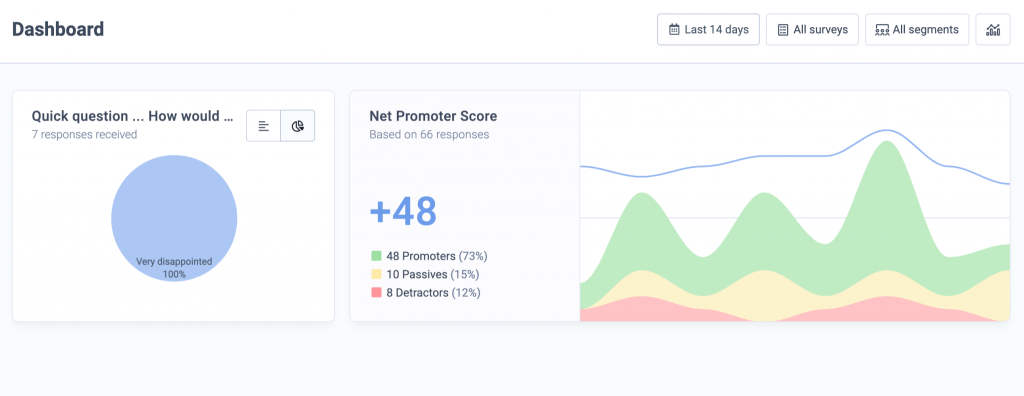
(NPS results dashboard in Refiner)
However, you might still need to manually analyze other data points (or, in the case of NPS or CSAT surveys, for example, insights customers provide when answering the follow-up question.)
Note – The key to this step is not just to go through the feedback. Your aim should be to uncover actionable insights that could help you drive better product, marketing, and business decisions.
And this brings us to the next step…
Step 3. Implementation
I’d imagine this is the most challenging aspect of the voice of the customer program for many.
Why? Because it requires you to act on the feedback and actionable insights you’ve collected to improve whatever areas of the business customers identified as requiring change.
Here are just some examples of how the voice of the customer insights can help improve different areas of the business:
- Product: VOC data can suggest ways to improve different features, simplify the interface, adjust pricing, or even change the language in the app.
- Customer service: With VOC insights, you can change the way your customer service team works, become more customer-centric, and even implement new technologies and tools to streamline how you support customers.
- Customer communication: Customer feedback might reveal where your SaaS is falling short when communicating with customers and suggest new channels to introduce or ways to improve the existing ones (i.e., live chat response times.)
- Marketing: The VOC program might reveal better ways to reach customers, phrases that better reflect how they talk about the product, or even how often they want to hear from you, and more.
Step 4. Update customer feedback
The program closes with another round of collecting feedback. This time, however, you do it not only to gather more insights.
You also aim to uncover how the changes you’ve implemented have affected your customers’ experience.
The good news is that these changes are easily quantifiable with data. By comparing specific insights, you can quickly uncover whether customers still mention a particular issue or challenge with the product, etc.
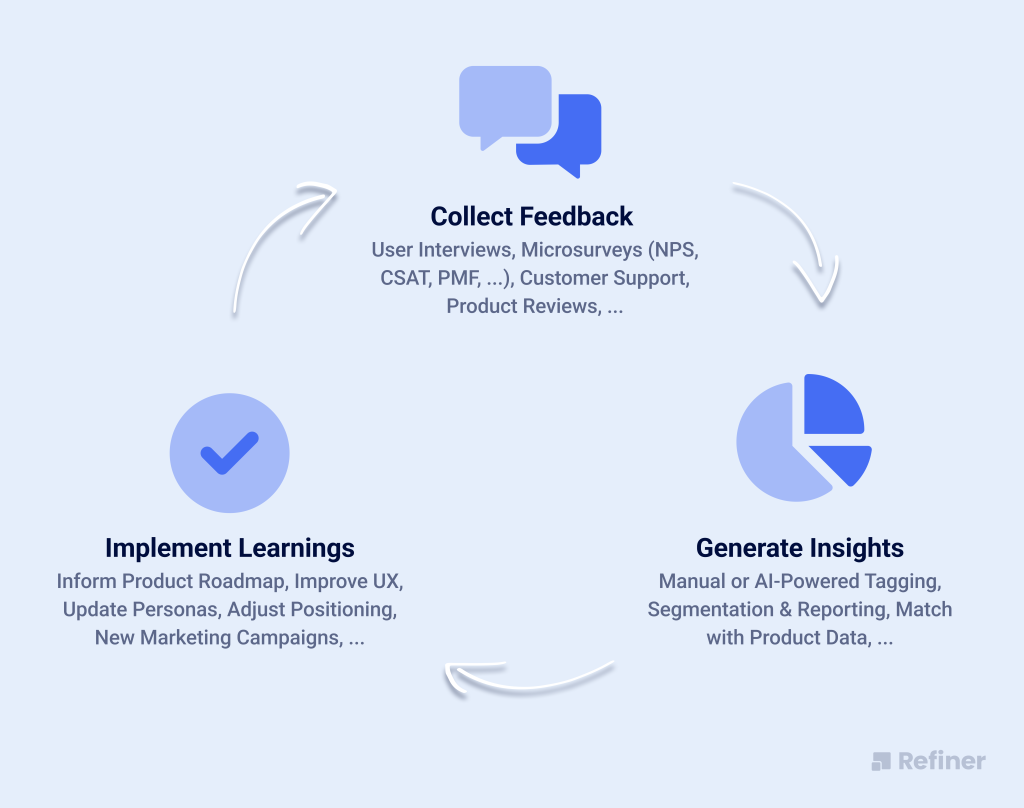
What Questions to Use in a Voice of the Customer Program
Customers often ask me about this, and I have to admit that it’s a tough question to answer. There are so many different insights that you may want to uncover with the voice of the customer program, after all. As a result, the number of potential questions to ask is practically infinite.
Having said that, I can give you some general advice on what type of information to look for and show you want types of questions that would help uncover it.
To make it easier to go through the list, I divided it by the type of feedback you might be looking for.
I. Customer experience and brand loyalty
Use NPS, CSAT, or CES surveys to collect this feedback. The most common questions to use in those surveys are:
- NPS question: How likely are you to recommend [PRODUCT] to friends or family? (see more NPS questions here)
- CSAT question: How satisfied are you with [PRODUCT]? (see more CSAT questions here)
- CES question: How easy was using [PRODUCT] so far? (learn more about CES surveys here)

Here are some examples of questions to ask when evaluating customers’ attitudes toward your product.
- What problem [PRODUCT] helps you overcome?
- Which feature do you use the most? (Alternatively, which feature [PRODUCT] must have to deliver value to you?)
- Is there a feature that you were looking for that our product does not have?
- What are the most important qualities that you look for in a product like [PRODUCT]?
III. Brand perception questions
Sometimes, you just want to know what customers think about your product or brand. In that case, some of the questions to ask include:
- What’s the first thing that comes to mind when you think about [BRAND/PRODUCT]?
- Where have you heard about our brand first?
- How did you hear about [BRAND/PRODUCT]
IV. Buying behavior questions
Finally, here are some questions that help you uncover your customers’ expectations and behavior across the entire buying journey.
- Did you find the information you were looking for on our website?
- What matters to you the most when selecting a product like [PRODUCT]?
- Could you name one competitor you think is better than [PRODUCT] and tell us why?
- Would you recommend [PRODUCT], and if so, why?
- What typically prevents you from trying out new SaaS products?
Naturally, these are only several of many possible questions. But I hope that they give you a good idea of how to structure the voice of the customer questions.
Best Tools to Run a Voice of the Customer Program
I’m sure this goes without saying; you need tools to collect and analyze the voice of the customer. The good news is that there are plenty of VOC platforms on the market. Below you’ll find a selection of the best ones to use.
#1. Refiner – Customer Feedback and Survey Software for SaaS
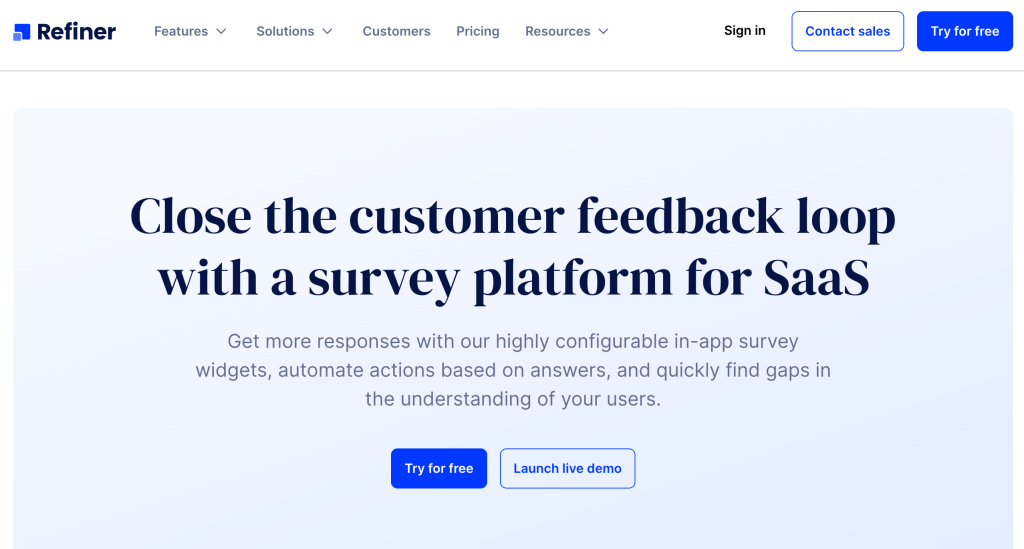
Refiner (disclaimer: this is our tool) is a complete customer survey platform explicitly built for SaaS.
Refiner allows you to survey users and collect precious voice of the customer feedback that will help you identify new ways to improve the product, grow the brand, and boost your customer satisfaction and engagement.
With Refiner, you can:
- Collect customer feedback with NPS surveys, CSAT, and CES surveys
- Create and send surveys via email, in-app widget, or survey pages
- Automate growth with precise targeting
- Leverage user data and survey responses to create personalized experiences
- Track and improve customer success
- Analyze survey results in-depth with reporting and segmentation features
- Integrate Refiner with Zapier, MixPanel, Google Sheets, AirTable, Hubspot, and more.
Refiner’s strict focus on customer feedback makes it the simplest tool to measure the voice of customers in SaaS.
Want to see how Refiner can help you collect incredible customer feedback and drive your VOC program? Check out the live demo or sign up for a free trial.
#2. Medallia – Customer Experience Platform

Medallia is quite a powerful and complex platform, offering all kinds of features to listen to and analyze the voice of the customer. With Medallia, you can monitor customer experience across the entire customer journey by evaluating data from multiple sources, from solicited feedback, online reviews, chat logs, behavioral data, and more.
#3. InMoment
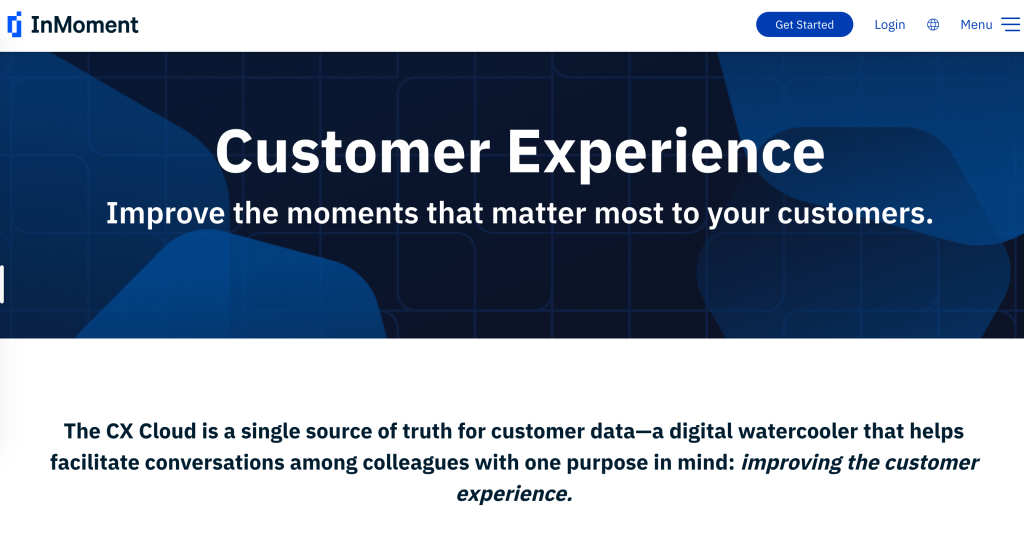
InMoment’s CX Cloud is another robust platform aiming to help organizations transform through the collection and analysis of the voice of the customer. In practical terms, this means that CX Cloud gives you all the tools to collect and analyze direct, indirect, and inferred feedback to make better business and product decisions. With the platform, you can listen to, analyze, and integrate customer feedback into your organization’s growth strategies.
#4. Qualtrics XMDiscover (formerly Clarabridge)
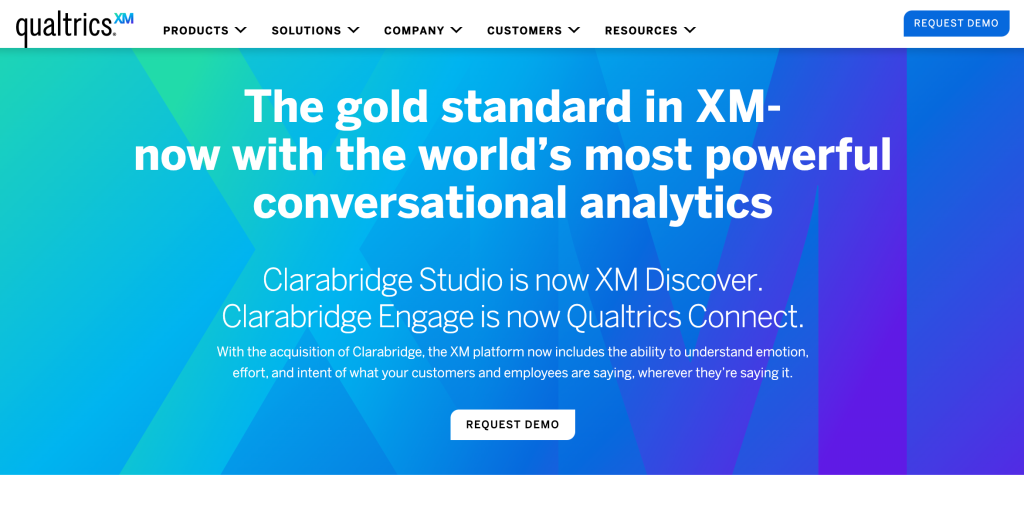
Qualtrics is another platform to collect, understand, and act on customer feedback and the voice of the customer. As the company states itself, the platform helps you “understand what people are saying about your company, wherever they’re saying it.” To achieve this, Qualtrics offers a whole range of feedback and analysis tools, from surveys, and brand monitoring, to data AI-driven analysis capabilities.
And that’s it…
Now you know what the voice of the customer program is, what it helps you achieve, how to get started, and even what tools to use.
What’s left is to start planning your VOC program and driving actionable decisions with the voice of the customer.
Good luck!

